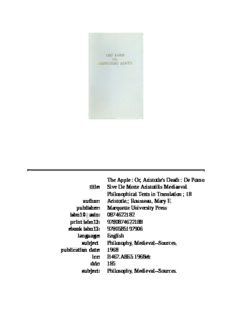
The Apple or Aristotle's Death (De Pomo Sive De Morte Aristitilis) PDF
Preview The Apple or Aristotle's Death (De Pomo Sive De Morte Aristitilis)
The Apple : Or, Aristotle's Death : De Pomo title: Sive De Morte Aristotilis Mediaeval Philosophical Texts in Translation ; 18 author: Aristotle.; Rousseau, Mary F. publisher: Marquette University Press isbn10 | asin: 0874622182 print isbn13: 9780874622188 ebook isbn13: 9780585197906 language: English subject Philosophy, Medieval--Sources. publication date: 1968 lcc: B467.A8E5 1968eb ddc: 185 subject: Philosophy, Medieval--Sources. Page i The Apple or Aristotle's Death (De Pomo sive De Morte Aristotilis) Page ii MEDIAEVAL PHILOSOPHICAL TEXTS IN TRANSLATION NO. 18 EDITORIAL BOARD James H. Robb, L.S.M., Ph.D., Chairman The Rev. Gerard Smith, S.J., Ph.D. The Rev. Michael V. Murray, S.J., Ph.D. The Rev. Richard E. Arnold, S.J., Ph.D. Paul M. Byrne, L.S.M., Ph.D. The Rev. John Sheets, S.J., S.T.D. Marquette University Press 1131 W. Wisconsin Avenue Milwaukee, Wisconsin 1968 Page iii The Apple or Aristotle's Death (De Pomo sive De Morte Aristotilis) Translated from the Latin with an Introduction by Mary F. Rousseau, M.A. Assistant Professor of Philosophy Mount Mary College Marquette University Press Milwaukee, Wisconsin 1968 Page iv Library of Congress Catalogue Card Number 68-28028 © Copyright, 1968, The Marquette University Press Milwaukee, Wisconsin Printed in the United States of America Page v To Edward, who has taken the root and delights in the fruit. Page vi Acknowledgements I wish to thank Panstwowe Wydawnictwo Naukowe, of Warsaw, for their permission to translate into English Marianus Plezia's Latin text of Aristotelis qui ferebatur Liber de Pomo; the Royal Asiatic Society of Great Britain and Ireland, for their permission to reprint Professor D. S. Margoliouth's English translation from Persian of The Book of the Apple, from the 1892 volume (n. s. XXIV) of the Journal of the Royal Asiatic Society of Great Britain and Ireland; and to the Cambridge University Press, for permission to quote from R. Hackforth's Plato's Phaedo Translated with Introduction and Commentary (Cambridge: University Press, 1955). Page vii Table of Contents Acknowledgements viii Note on Abbreviations [1] Preface [3] Translator's Introduction Section I, The Doctrinal Development of The Apple [11] Section II, The History of The Apple, (A-P) [28] Section III, The Manuscript Tradition of the Latin [38] Version of The Apple The Apple, or Aristotle's Death [48] Appendix: Margoliouth's Translation of the Persian [60] Version of The Apple Bibliography [77] Page 1 Note on Abbreviations The treatise under question in this study is one work, although it exists in several versions in various languages. Its earliest form is an Arabic version which became known to the modern world through a quite accurate Persian translation after the Arabic text itself was lost. A thirteenth century Hebrew version which purports to be a translation of the Arabic is so loosely done and so extensively modified from the original as to constitute a basically different, second version. The work is also referred to by several different, though similar, titles. In order to reduce this confusion, I shall refer to the work throughout my study by its simplest title: The Apple. Variants of this title will be noted when necessary. Statements about The Apple which do not specify any particular version are meant to apply to it generally, in all its known versions and translations. The second, or Hebrew, version was soon translated into Latin and became enormously popular in medieval Europe. This Latin version, which closely follows the Hebrew and thus drastically departs from the Arabic original, is the chief focus of my study. But the other versions are also treated, though incidentally, as they illumine the Latin. Thus it is necessary to specify at times which version I am referring to. In order to simplify these references, I have devised the following abbreviations: (1) A-P. This symbol refers to the Arabic-Persian version. The Persian translation has been published, whereas the recently discovered Arabic text has not. Thus the Persian text is at present our closest access to the original. (2) H-L. This symbol refers to the second, the Hebrew-Latin version. In this study of medieval scholasticism, I am directing primary attention to the Latin translation of the Hebrew. (3) One large part of my study is of the manuscript tradition of the Latin version. My work here is based on the catalogue of medieval Latin manuscripts of Aristotle, Aristoteles Latinus, assembled by Dulong, Franceschini, Lacombe, and Birkenmajer. The codices catalogued in Aristoteles Latinus are numbered consecutively throughout the three volumes. Thus I have found it convenient to refer to the Latin manuscripts of The Apple by their numbers in this catalogue. A typical citation will be AL 1774. (4) The early printed versions of the Latin text are referred to by their numbers in Gesamtkatalog Der Wiegendrucke, thus: GKW 2450. For those which are available in American libraries, I also cite a number from Stillwell's Incunabula and Americana 1450-1800. An example of such citations is A860. (5) Finally, I refer frequently to Moritz Steinschneider's catalog
